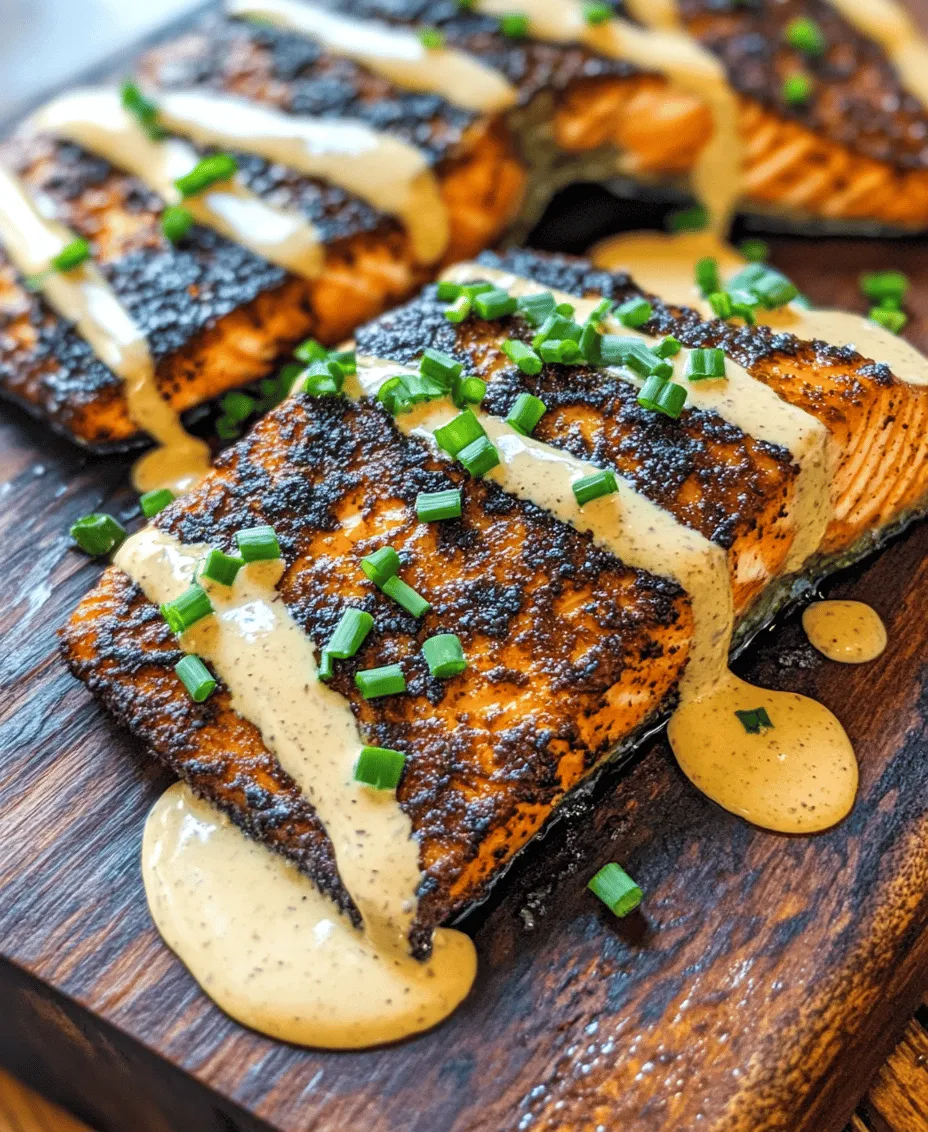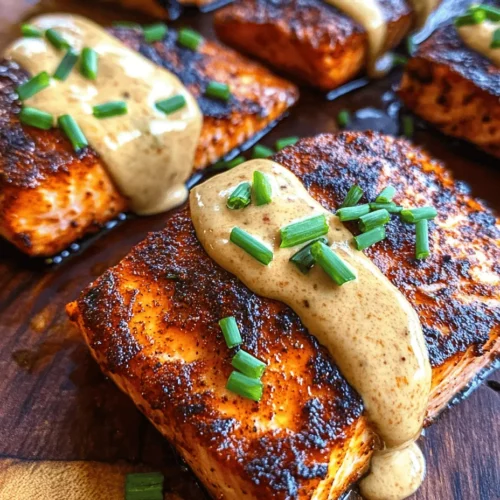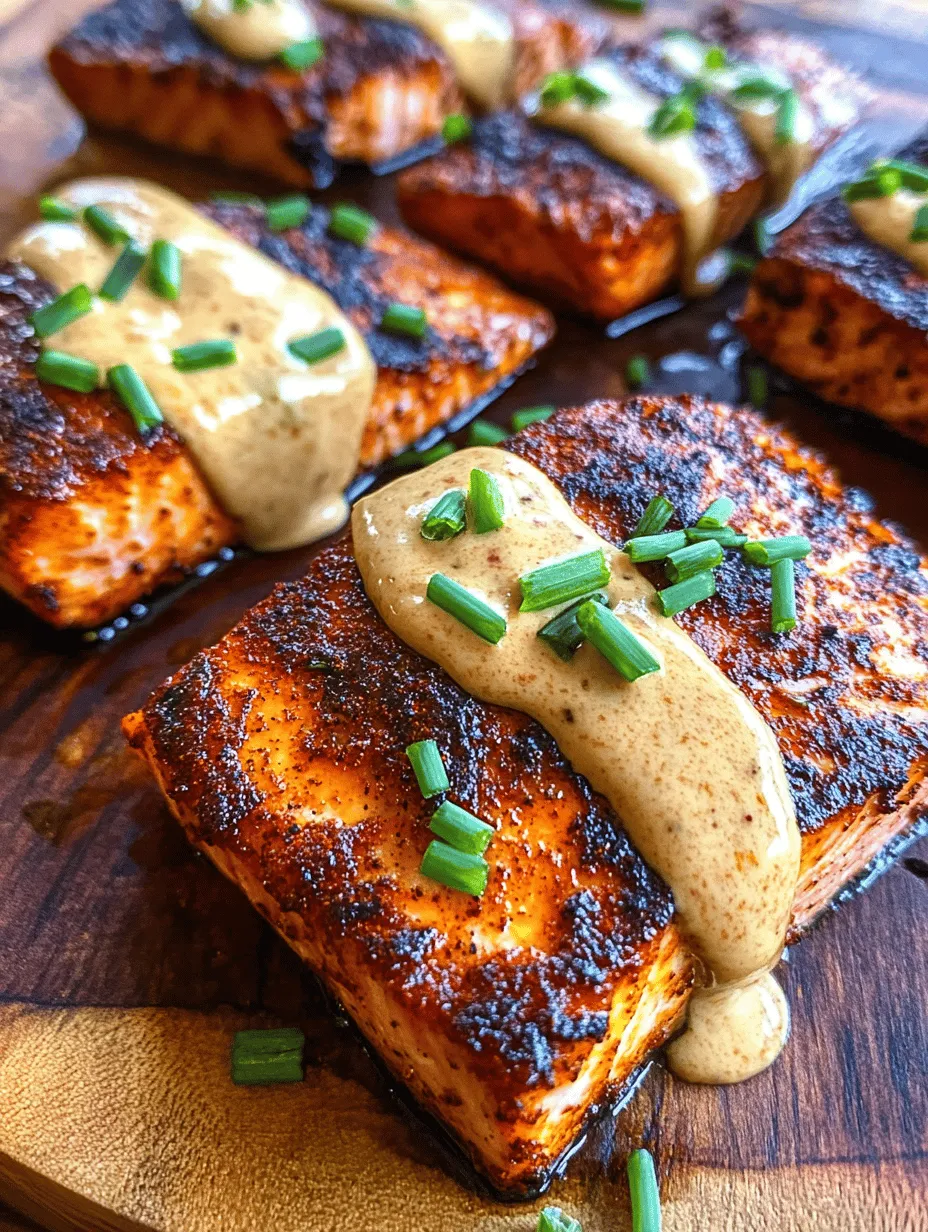Introduction
If you’re looking for a meal that combines rich flavors, healthy ingredients, and quick preparation, look no further than blackened salmon with creamy Dijon sauce. This dish not only delivers a punch of taste but also offers a nutritious option for dinner that can be enjoyed by the whole family. Salmon has become a culinary favorite due to its versatility and health benefits, making it a staple in kitchens around the world. With its tender, flaky texture and ability to absorb a variety of flavors, salmon is the perfect canvas for the bold, spicy notes of the blackening technique paired with the creamy, tangy Dijon sauce.
The Allure of Blackened Salmon
The blackening technique originated in Louisiana, where it was popularized by renowned chef Paul Prudhomme. This method involves seasoning fish or meat with a robust blend of spices and then cooking it at high heat, often in a cast iron skillet. The result is a beautifully charred exterior that locks in moisture and enhances the natural flavors of the salmon. The blackened crust forms through the Maillard reaction, creating a savory, smoky, and slightly spicy flavor profile that is simply irresistible.
The nutritional benefits of salmon are noteworthy as well. Rich in omega-3 fatty acids, salmon is known for its heart-healthy properties, contributing to lower blood pressure and reduced risk of heart disease. It is also an excellent source of high-quality protein, vitamins B12 and D, and essential minerals like selenium. With these health benefits and its delectable taste, it’s no wonder salmon has become a popular choice among health-conscious eaters and food enthusiasts alike.
Ingredients Breakdown
To create this delicious blackened salmon with creamy Dijon sauce, you’ll need a few key ingredients that work harmoniously together. Here’s a detailed list of what you’ll need along with tips for sourcing quality ingredients.
Ingredients for Blackened Salmon
– Salmon Fillets: When selecting salmon, look for fresh, wild-caught fillets if possible. Wild salmon tends to have a richer flavor and firmer texture compared to farmed salmon. Check for vibrant color and a clean smell, avoiding any fillets that appear dull or have a fishy odor.
– Spice Blend: The heart of the blackening technique lies in the spice blend. For optimal flavor, use fresh spices. Here’s a breakdown of the spices you’ll need:
– Paprika: Adds depth and a sweet smokiness.
– Garlic Powder: Brings a robust flavor that complements the fish beautifully.
– Onion Powder: Enhances the savory notes of the dish.
– Cayenne Pepper: Provides the heat; adjust the amount based on your spice preference.
– Thyme: Offers an earthy flavor that pairs well with salmon.
– Oregano: Adds a hint of Mediterranean flair.
– Olive Oil or Butter: Both options work well for cooking the salmon. Olive oil is a heart-healthy fat that enhances the dish’s flavor, while butter brings a rich creaminess. You can also use a combination of both for a balanced taste.
Ingredients for Creamy Dijon Sauce
The sauce is what takes this dish to the next level. It’s creamy, tangy, and complements the salmon perfectly.
– Sour Cream: This is the base of the sauce, providing creaminess and tang. For dietary preferences, you can substitute with Greek yogurt for a lighter option or use a non-dairy yogurt for a vegan alternative.
– Dijon Mustard: The star ingredient of the sauce, Dijon mustard adds a sharp, tangy flavor. There are various brands and flavor variations available, so choose one that suits your taste.
– Lemon Juice: Freshly squeezed lemon juice adds brightness and acidity, balancing the richness of the sauce.
– Honey: A touch of sweetness helps to round out the flavors. Feel free to adjust the amount of honey to your preference, or omit it for a more savory sauce.
Preparation Steps for Blackened Salmon
Now that you have all your ingredients ready, it’s time to prepare your blackened salmon. Follow these step-by-step instructions to ensure maximum flavor and a perfectly cooked dish.
Step 1: Prepare the Spice Blend
Start by creating your spice blend. In a small mixing bowl, combine the paprika, garlic powder, onion powder, cayenne pepper, thyme, and oregano. Mix these spices thoroughly to ensure an even distribution of flavors. The aroma of the spices will immediately elevate your anticipation for the dish.
Step 2: Season the Salmon
Pat the salmon fillets dry with paper towels to remove any excess moisture. This step is crucial for achieving a good sear. Once dry, drizzle a small amount of olive oil or melted butter over the fillets. This will help the spice blend adhere to the salmon while also contributing to the crispy crust.
Generously sprinkle the spice blend over both sides of the salmon fillets, pressing gently to ensure the spices stick. The vibrant colors of the spices will create a beautiful visual contrast once cooked.
Step 3: Heat the Skillet
Preheat a cast iron skillet over medium-high heat. If you don’t have a cast iron skillet, a non-stick skillet can also work. Add a tablespoon of olive oil or butter to the hot skillet, allowing it to melt and coat the bottom evenly. The oil should shimmer but not smoke; adjust the heat if necessary.
Step 4: Cook the Salmon
Carefully place the seasoned salmon fillets into the hot skillet, presentation side down (the side with the skin, if applicable, should face up). Allow the fillets to cook undisturbed for about 4-5 minutes, depending on the thickness of the fillets. You want to create a dark, crusty exterior while keeping the inside moist and tender.
Once the bottom is beautifully blackened, gently flip the salmon using a spatula and cook for an additional 3-4 minutes, or until the salmon reaches your desired doneness. The internal temperature should reach 145°F (63°C) for perfectly cooked salmon.
Step 5: Prepare the Creamy Dijon Sauce
While the salmon is cooking, you can prepare the creamy Dijon sauce. In a separate small bowl, combine the sour cream, Dijon mustard, lemon juice, and honey. Whisk these ingredients together until smooth and creamy. Taste and adjust the seasoning, adding more lemon juice for acidity or honey for sweetness as desired.
By following these steps, you’ll be well on your way to creating a delicious blackened salmon dish that’s bursting with flavor and nutrition. Stay tuned for the final touches, serving suggestions, and tips for making this meal your own.

Importance of Drying the Salmon Fillets Before Seasoning
Before diving into the cooking process for your Blackened Salmon with Creamy Dijon Sauce, it’s essential to address one crucial step that can significantly influence your dish’s outcome: drying the salmon fillets. Moisture on the surface of your fish can prevent the seasoning from adhering properly and can result in steaming rather than searing when it hits the hot skillet.
To prepare your salmon, use paper towels to pat the fillets dry thoroughly. This simple yet effective technique allows the spices to form a flavorful crust during the cooking process, leading to a beautifully charred exterior. Remember, achieving that coveted blackened effect relies on the interaction between the dry seasoning and the high heat of the skillet.
Techniques for Applying Olive Oil or Butter Effectively
After ensuring your salmon fillets are dry, the next step is to apply olive oil or butter. Either choice will enhance the flavor and aid in forming a crust. When using olive oil, drizzle a small amount directly onto the fillets and rub it in gently with your fingers or a brush. This method ensures even coverage and prevents the fillets from sticking to the skillet.
If you prefer to use butter, consider melting it first, then brushing it onto the salmon. This technique not only adds rich flavor but also helps the seasoning stick better. The key is to use just enough fat to create a barrier between the fish and the skillet, promoting a perfect sear without excess grease.
Searing the Salmon: Temperature Control and Skillet Choice
For the best results when searing salmon, temperature control is paramount. Start by preheating your skillet over medium-high heat for a few minutes until it’s hot, but not smoking. A cast-iron skillet is the ideal choice for blackening because it retains heat exceptionally well and distributes it evenly, allowing for a consistent cooking surface that helps achieve that signature char.
Carefully place the seasoned salmon fillets into the hot skillet, skin-side down if the skin is left on. Avoid overcrowding the pan; this will lower the temperature and result in uneven cooking. If necessary, cook in batches to maintain optimal heat. The fillets should sizzle upon contact, signaling that you’ve reached the right temperature.
Benefits of Using a Cast-Iron Skillet for Blackening
A cast-iron skillet is particularly beneficial for blackening salmon due to its heat retention properties. With cast iron, you achieve a high, steady temperature, which is crucial for creating that blackened crust. The skillet’s ability to withstand high heat allows the spices to caramelize, enhancing the flavors.
Moreover, cast iron develops a natural non-stick surface over time, making it easier to release the salmon fillets without losing any precious crust. If you’re looking for that deep, smoky flavor associated with blackened dishes, a cast-iron skillet is your best friend.
Discussion on Cooking Times for Perfect Doneness
Cooking time for salmon will depend on the thickness of your fillets. As a rule of thumb, cook the salmon for about 4-5 minutes per side for a standard fillet. You can gauge doneness by observing the color; the salmon should be opaque and easily flake with a fork. For a more precise method, use an instant-read thermometer to check for an internal temperature of 145°F.
Once you’ve flipped the fillets, avoid pressing down on them; this can cause them to dry out. Instead, let them cook undisturbed to allow the crust to form. If you prefer your salmon medium-rare, aim for an internal temperature of around 125°F.
Crafting the Creamy Dijon Sauce
While your salmon is cooking, you can prepare the Creamy Dijon Sauce that will elevate your dish to new heights. Here’s a step-by-step guide to crafting this delicious accompaniment.
1. Gather Your Ingredients: You will need Dijon mustard, heavy cream, lemon juice, minced garlic, salt, and pepper.
2. Mix the Sauce: In a medium bowl, combine 1/4 cup of Dijon mustard with 1 cup of heavy cream. Stir until well blended.
3. Add Flavor: Incorporate 1 tablespoon of lemon juice and 1 clove of minced garlic. Mix thoroughly.
4. Season: Taste the sauce, then add salt and pepper to your liking. You can adjust the mustard level for more tang or add a splash more cream for a milder flavor.
5. Whisk for Smooth Texture: For a velvety sauce, whisk vigorously until it’s well combined and free of lumps.
Tips for Adjusting Flavors to Personal Preference
Feel free to experiment with the sauce ingredients to suit your taste. For example, adding fresh herbs like dill or tarragon can provide an aromatic touch. If you enjoy a bit of heat, consider whisking in a pinch of cayenne pepper or a dash of hot sauce. The versatility of this sauce allows it to pair beautifully with various proteins, making it a useful recipe to keep on hand.
Serving and Storage Suggestions for the Sauce
Once your sauce is prepared, you can serve it warm over the blackened salmon or on the side for dipping. If you have leftovers, store the sauce in an airtight container in the refrigerator for up to a week. When ready to use, simply reheat gently on the stove or microwave, whisking to restore its creamy consistency.
Serving Suggestions for Blackened Salmon
When it comes to serving Blackened Salmon with Creamy Dijon Sauce, a few accompaniments can truly enhance the meal. Here are some ideal pairings:
– Rice: Fluffy jasmine or basmati rice is an excellent choice to soak up any extra sauce.
– Sautéed Vegetables: Consider light sautéed vegetables like zucchini, bell peppers, or asparagus for a colorful and nutritious side.
– Fresh Salads: A crisp green salad with vinaigrette can provide a refreshing contrast to the rich flavors of the salmon and sauce.
Presentation Tips for an Appealing Meal
For an aesthetically pleasing plate, place the salmon fillet at the center, drizzling the creamy sauce generously over the top. Garnish with freshly chopped herbs like parsley or chives for a pop of color. You can also add a wedge of lemon on the side for an extra burst of freshness.
Nutritional Information
This Blackened Salmon with Creamy Dijon Sauce is a wholesome dish, rich in protein and healthy fats. A typical serving of salmon (approximately 6 ounces) contains around 367 calories, 40 grams of protein, and 22 grams of fat, making it an excellent choice for a balanced meal. The addition of the creamy sauce contributes around 100 calories per serving, depending on the specific quantities used.
Discussion on Portion Sizes and Balanced Meal Ideas
Portion sizes can vary based on dietary needs, but a 6-ounce serving of salmon is a good standard for adults. To create a balanced meal, aim to fill half your plate with vegetables, a quarter with protein, and a quarter with grains, such as rice or quinoa. This approach ensures you’re getting a variety of nutrients while enjoying the savory flavors of your dish.
Conclusion
In summary, Blackened Salmon with Creamy Dijon Sauce is a delicious, easy-to-prepare dish that will impress your family and friends. With its rich flavors and the perfect combination of textures, this recipe is sure to become a staple in your kitchen. Don’t hesitate to experiment with different herbs, spices, and side dishes to make it your own. Whether you’re preparing a weeknight dinner or a special occasion meal, this dish promises satisfaction and culinary delight. Enjoy the process of cooking, and let this recipe inspire your culinary creativity!



